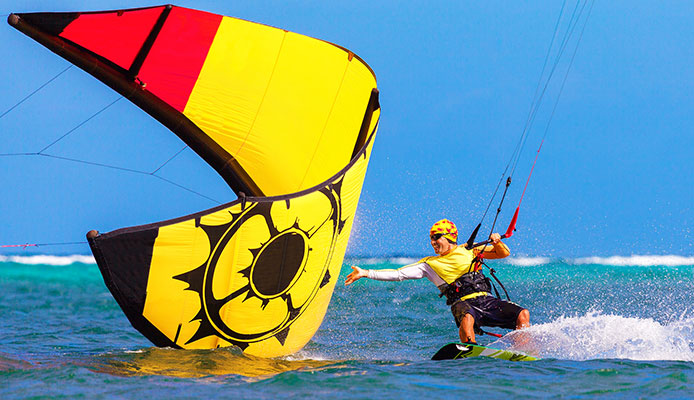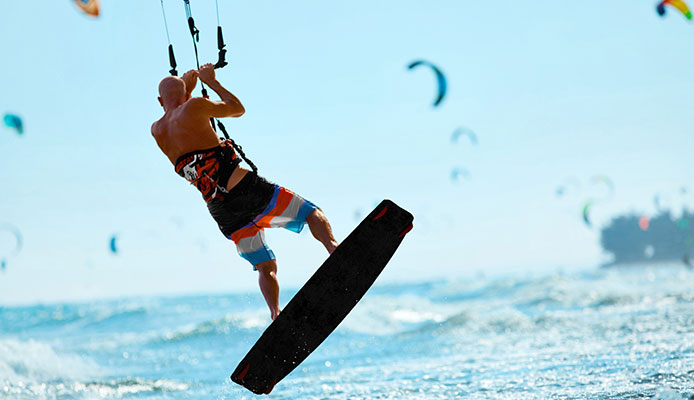
Ever want to combine the wave-breaking high of surfing with the vertiginous adrenaline rush of paragliding? Kiteboarding, a relatively new board sport that is gaining momentum worldwide, does just that.
Kiteboarders strap themselves onto high-tech kiteboards and then launch themselves onto the surf, propelled by a kite, slicing the waves, and acrobatically maneuvering off and on the water to reach speeds as high as 40 mph.
In this guide, we will help you figure out what is kiteboarding. To help you get started with this sport, we will outline the tips you need to know when learning how to kiteboarding.
What is Kiteboarding?
Kiteboarding is a wind-powered, human-controlled extreme sport where users harness 2 common elements – wind (with their kite) and water (with their kiteboard) to achieve movement. Kiteboarding blends aspects of windsurfing, surfing, wakeboarding, and paragliding into one water sport.
Unlike kitesurfers who use directional boards, kiteboarders use a twin-tip board with their feet strapped into bindings like they would on a wakeboard. The kite acts like a parachute while it is attached to the rider via a harness. The power of the wind helps the kiteboarders lift themselves many feet into the air to perform big tricks. The kiteboarders use a hand-held control system that allows them to steer (or control) their kite.
How to Kiteboarding: Tips to Help You Get Started
1. Work with a Professional Instructor
Being an extreme sport, kiteboarding demands both technical and physical know-how. Kiteboarding is not a sport that can be learned via a video or individual practice in a couple of hours. You need to enroll in a good beginner kiteboarding school to work with a professional in your initial learning phase.
This will help you understand how to handle your gear, how to orient it correctly, and how to avoid making mistakes that could cost you your safety and that of other kiteboarders. A good instructor will also help you determine the safe zones on your favorite kiteboarding sports – this can help you avoid areas that can easily lead to injuries.
2. Get Basic Gear
After finishing your lessons on how to kiteboarding, you can go ahead and pick out some gear to get your new sport started. A starter kit will include:
- 1 Kite
- A hand-held control mechanism
- A board
- Harness
- Set of lines
- Pump
- Carrying bag
As you get more experienced, you can add more gear so you can ride in varied conditions. Consider asking your instructor for their opinion – they can recommend gear that best suits your body size and type of riding.
3. Understand Where the Wind is Coming from
You can determine where the wind is coming from without using a wind meter. To do this, you will need to:
- Throw sand in the air and watch the direction it blows towards
- Notice the direction the flags are blowing
- Turn your head slowly until you hear the wind blowing in both ears. This should show you where the wind is coming from.
4. Determine the Wind Direction Relative to the Shore
When learning how to kiteboarding, the following wind directions will make your learning experience both safe and smooth:
- Cross-onshore – This is when the wind blows parallel to the shore, sometimes swinging to the shore.
- Cross-shore – This is when the wind blows parallel to the shore without swinging towards it.
Both wind directions allow you to surf while staying close to the shore. If your kit fails or you get exhausted, getting back to the shore will be easy.
You might also like: Perfect Kiteboarding Helmets
5. Use the Right Wind-Window to Launch
Once you put on your board shorts and rash guard – or a surfing wetsuit in the event of cold conditions – you will need to wait for the perfect wind window to launch your kite. You can think of the wind window as a three-dimensional “window” downwind relative to you. When you stand with your back to the wind direction, everything that you can see from your sides to your front and the space just above your head will be your window.
For people learning what is kiteboarding, using the half clock shape makes it much easier to understand the wind window:
- When the kite is at the 12 o’clock position – that is, when it straight over your head – the wind is at maximum power. You should avoid this position since a strong gust of wind can easily suck you up high into the air, blowing you into obstacles.
- The most ideal position to launch is when the kite is either at 3 o’clock or 9 o’clock. This should offer you an ideal half wind window, depending on your direction of travel.
FAQs

Q: How Dangerous is Kiteboarding?
As long as the rider knows what he/she is doing, kiteboarding is a very safe sport. With only 7 injuries per 1000 hours of activity, kiteboarding is safer than American football which has 36 injuries per 1000 hours, and even soccer which has 19 injuries per 1000 hours.
Q: Is Kitesurfing Difficult to Learn?
Being more technical, kiteboarding may be harder to learn than wakeboarding. However, its learning curve is faster compared to windsurfing, with kiteboarders advancing quickly after their initial lessons. The hardest part is generally getting started – once you can ride your kite, moving on from a beginner to an expert is pretty easy.
Q: What Does Kitesurfing Involve?
Kiteboarding is a wind-powered surface watersport that uses a kite and a board to move across the water. Kiteboarders harness the power of the wind through their kites to propel themselves across the water on a kiteboard. A hand-held control mechanism helps control the kite.
Globo Surf Overview
Though extremely fun and exhilarating, kiteboarding can be intimidating to get started with, with most beginners finding it hard to properly divide their attention between controlling their board and flying their kite. In addition to providing a detailed answer to what is kiteboarding, this article has tips you can use when learning how to kiteboarding. The guide is designed to help you speed up the rate at which you learn kiteboarding.

